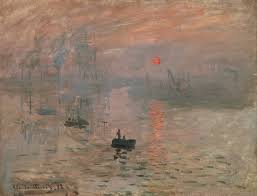Michael Fried at nonsite:
 Specifically, I want to suggest that the advent of Impressionism around 1870 marks a fundamental break in what I will call the dialectical continuity of French painting going back to the middle of the eighteenth century, when a new conception of the absorptive and dramatic tableau came to the fore in the paintings of Jean-Baptiste Greuze (themselves inconceivable apart from the precedent of the genre paintings of Jean-Baptiste-Siméon Chardin) and the art critical and theoretical writings of the polymath philosophe Denis Diderot, the founder of art criticism as we know it. This is the fateful development analyzed in my 1980 book, Absorption and Theatricality: Painting and Beholder in the Age of Diderot, in which I argue (I would like to think I demonstrate) that starting in the mid-1750s and 1760s in France the art of painting found it necessary to confront a new imperative: to find the means to suspend or neutralize—to somehow wall off—the now suddenly distracting presence of the beholder; or to put this slightly differently, to somehow establish the supreme fiction or ontological illusion that the beholder does not exist, that there is no one standing before the painting. I describe this imperative in terms of a need to stave off, if possible to overcome, a newly distinct danger of theatricality. And I argue that this was to be accomplished with the aide of two principal strategies: first, the thematization of absorption, which is to say the depiction of personages each of whom was felt to be entirely caught up (absorbed) in whatever was understood to be taking place within the representation; and second, the promotion of a new, more exigent ideal of dramatic unity, according to which all the elements in the painting were directed toward a single dramatic end, thereby achieving a compositional effect of closure vis-à-vis the beholder.
Specifically, I want to suggest that the advent of Impressionism around 1870 marks a fundamental break in what I will call the dialectical continuity of French painting going back to the middle of the eighteenth century, when a new conception of the absorptive and dramatic tableau came to the fore in the paintings of Jean-Baptiste Greuze (themselves inconceivable apart from the precedent of the genre paintings of Jean-Baptiste-Siméon Chardin) and the art critical and theoretical writings of the polymath philosophe Denis Diderot, the founder of art criticism as we know it. This is the fateful development analyzed in my 1980 book, Absorption and Theatricality: Painting and Beholder in the Age of Diderot, in which I argue (I would like to think I demonstrate) that starting in the mid-1750s and 1760s in France the art of painting found it necessary to confront a new imperative: to find the means to suspend or neutralize—to somehow wall off—the now suddenly distracting presence of the beholder; or to put this slightly differently, to somehow establish the supreme fiction or ontological illusion that the beholder does not exist, that there is no one standing before the painting. I describe this imperative in terms of a need to stave off, if possible to overcome, a newly distinct danger of theatricality. And I argue that this was to be accomplished with the aide of two principal strategies: first, the thematization of absorption, which is to say the depiction of personages each of whom was felt to be entirely caught up (absorbed) in whatever was understood to be taking place within the representation; and second, the promotion of a new, more exigent ideal of dramatic unity, according to which all the elements in the painting were directed toward a single dramatic end, thereby achieving a compositional effect of closure vis-à-vis the beholder.
more here.
